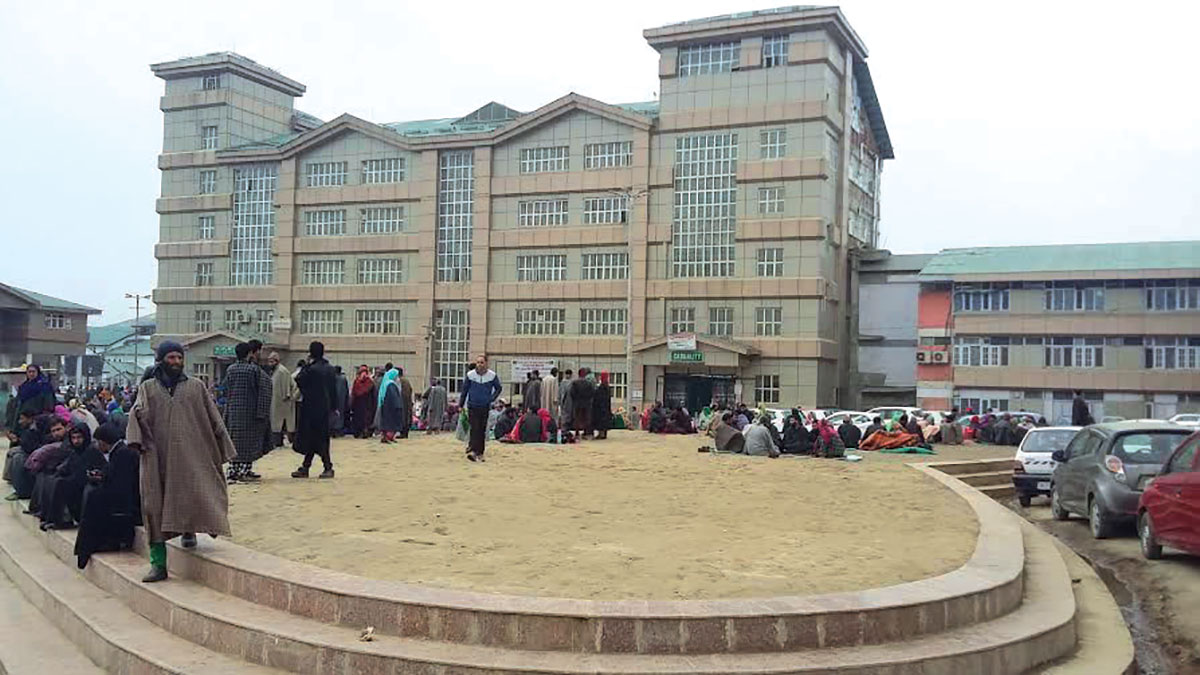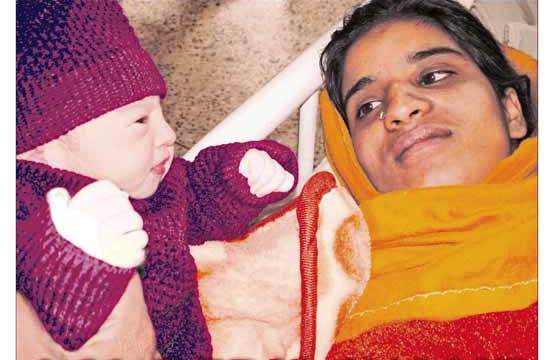Kashmir is witnessing almost half of the new births having a surgical intervention, a new trend that defies logic and tradition besides exhibiting complete intolerance to the idea of pain in the new generation. As the policymakers intend to reverse the trend, Syed Samreen explores the diverse aspects of the C-section motherhood

The first thing that comes to a pregnant woman’s mind around the time of her labour is whether she will deliver the baby naturally or by being operated upon. Ideally, no woman ever would prefer a surgeon’s knife but somehow the whole scenario is upside down. There are more caesareans; colloquially known as C-section – medically called lower segment caesarean section (LSCS), in Kashmir in comparison to the normal and natural deliveries.
District wise statistics of deliveries across Kashmir districts suggest that in 2019-20 there were 51864 deliveries, of which 22885 were LSCS and 28,979 were normal deliveries. In 2020-21, out of 40397 deliveries, 17,078 were LSCS and 23319 were normal. In 2021-22, the financial year that ended in March, of 38182 deliveries, 17,616 were C-sections and 20566 were normal deliveries.
The district-wise breakup of the data suggests that the highest number of caesareans in 2019-20 were performed in Baramulla with the number being 5425. For the next two years, it was Pulwama at top of the list with 2865 and 3469 C-section deliveries, respectively.
Traditional Midwives
The surge is being termed to be a recent phenomenon as almost a decade back natural deliveries would outnumber the C-sections. Deliveries would take place with the help of traditional and trained midwives and the surgeons would only take care of cases having a risk of maternal mortality or cases where experts’ intervention was needed.
Midwives would use traditional skills, acquired through generations of wisdom, and the power of communication in helping younger women have successful deliveries. Almost every village in the periphery and Mohalla in urban spaces had a midwife who would reach out to pregnant women at the time of their parturition. This paradigm shift in the field of obstetrics seems more like a retreat than a progression; keeping in view the benefits of normal deliveries and the long-term side effects of delivering a baby by C-section.
A Paradigm Shift
What can be the possible reason behind this proclivity for surgery but nature? Experts say the answer is not in black and white. While many of them assert the fact that it is women who choose painless procedures; caesareans, over normal deliveries, others claim it is the medical staff that avoids fatigue and performs the childbirth cursorily, avoiding the day-long labour and the constant succour, needed by the patient. What is interesting, both sides of the debate have enough details to support their arguments.

Privately run hospitals being thronged by expecting mothers on daily basis have earned a reputation for the C-section. Normally, these hospitals manage C-section load only in the entire obstetrics.
Muzaffar Jan Pattoo, the head of Kashmir Private Hospitals and Nursing Homes Association, who runs the premier Modern Hospital in Srinagar said they offer the infrastructure and the decision to the surgery or normal delivery is something that pertains to the patient and a doctor.
“You can see that the C-sections are going up worldwide and the same is the case with Kashmir. This is prevalent in the government sector as well, not just the private sector, albeit, the percentage remains higher in the private hospitals,” Jan said. “The womenfolk are not ready to experience labour. There have been cases where the patients were ready to deliver babies naturally but they finally ended up opting for C-section, solely on their request, even when the doctor was very keen to assist the patient with normal delivery.”
The tolerance threshold has gone down in people as well. Now almost seventy per cent of the women deliver babies via C-section.
Is there an economy encouraging the process? Jan said the costs may vary between a hospital to hospital but the costs rarely cross Rs 30,000.
Jan said a part of the costs that pertain to the hospital directly are the charges regarding infrastructure and that will come to them regardless of the patient choosing C-section or normal delivery. People, he said, come to the private sector for better facilities for which they are willing to pay. “You should also keep in mind that the private health sector in Kashmir is the cheapest in India,” Jan asserted.
Official Take
An official in the Directorate of Health Services, Kashmir (DHSK), (who wished to remain off the record) emphasised the fact that women require counselling during childbirth. “If all the government and private hospitals offer to counsel to patients and enlighten them about the benefits of delivering naturally, the normal deliveries can go up,” the official said.
Asked if they can consider it, Jan said, it is possible “but the service can not come free and it will shoot up the costs as the councillors will have to stay around the patient till the delivery takes place.”
In Srinagar, there are around twenty private hospitals with a few more coming up and overall, fifty across Kashmir. Comparatively, the rates are low as compared to other private hospitals all over the country, but it still remains a costly affair in Kashmir.

The Other Factors
A number of other factors play up in the process. There is an element of mistrust amongst the womenfolk who believe the nursing staff is not supportive and is more or less robotic.
Patients feel comfortable with the presence of doctors all through their delivery time. Unlike public sector hospitals, this facility is assured in private hospitals and that is why most of the young couples prefer the private sector.
“The problem has multiple factors,” explains Dr Mir Mushtaq, the spokesman for DHSK said. “There is definitely a paradigm shift. Twenty years down the line, there used to be just normal deliveries. Now the trend has shifted. I think that the patients need to be counselled. Young ladies have many questions and false perceptions regarding labour. The benefits need to be explained to them. Before the mother comes for the delivery, she needs to be prepared for a natural delivery. Most people prefer caesarean. In order to reverse this worrying trend, we all have to work together. Joint efforts are needed from doctors, the families of the patient, the patient most importantly, as well as the nursing and paramedic staff.’
The doctor said the problem cannot be solved by a blame game, if at all anyone has to be blamed, it has to be all the parties included.
“I will suggest that we need to train our staff as well; the paramedical staff, the Asha-workers, the doctors and the nurses,” Mushtaq said. “All need to be part of the system. Labour is a physiological process; it is unfortunately been perceived as a disease. It is a natural course which just needs to be monitored. If only there is an emergency, then only there needs to be intervention,”
Patient Tales
The patients have a similar story that doesn’t differ much. They fear being left unattended and they have a low tolerance for pain.
Shahnaza Hajam from Baramulla gave birth to three of her children in Lala Ded Hospital ( in Srinagar. Every time, he went under a surgeon’s knife. Asked why she choose it, Shahnaza said held her treating doctors responsible. “The doctors don’t wait for normal delivery. They simply give an appointment for the surgery months before,” she said. “It also depends on luck; I think I wasn’t lucky enough to deliver my children naturally.”
Another patient, Shameema Bano (name changed) while lying on the hospital bed in LD hospital, holding her newborn tight against her bosom, let out a cry of pain and exclaimed, “this is my second issue and it is a boy. I am very happy even though its hurting down there. I had my first baby by C-section and was told that I wouldn’t be able to deliver normally the second time. I didn’t care how much it would hurt, either way, I just wanted my baby and me to be safe so I went ahead and opted for the C-section.”
Dr Hina Bashir Shah, Professor in Government Medical College (GMC) Anaesthesiology and Critical Care said there are almost 200 admissions in LD Hospital per day. Attending all the patients for normal delivery is almost an impractical job due to a load of patients and a lack of manpower.
Normal deliveries are typically either painful or painless. In cases of painless normal deliveries, which are very few, not much intervention is needed. However, in painful normal deliveries, epidural analgesia is needed that reduces the pain during labour. “We can’t administer more than a few epidural analgesias because these patients require constant monitoring for hours together, and for that, we need infrastructure and manpower,” the anesthesiologist added.
The LD Hospital is the only apex maternity centre in Kashmir where patients from all over the valley receive obstetric care. In the year 2019-2020 the total number of normal deliveries was 8215 while caesareans were almost double, 14,988. In 2020-2021 the number of normal deliveries was 7078 while the caesareans performed were 12,524, and from 2021 until February 2022, the normal deliveries that took place were 6,986 while the caesareans performed were a whopping 12,256 in the hospital.
Recent Survey
The National Family Health Survey -5 has painted quite a grim picture of Jammu and Kashmir where against an average of 10-15 per cent LSCS almost half of the childbirths have child interventions. This has led the administration to intervene and reverse the trend to a reasonable extent. The goals have been already set. But more than money, it will involve a lot more manpower in hospitals in the coming days including a new chain of maternity councillors who will start working from the very start of the pregnancy. It only remains to be seen how the trend is undone.















